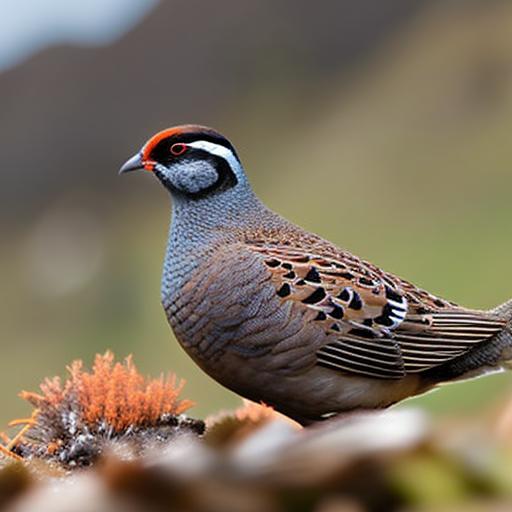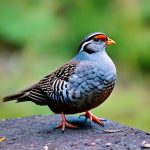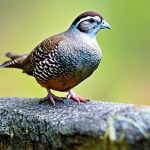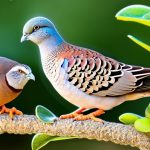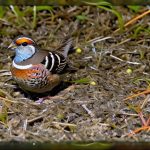Mountain quail, also known as Oreortyx pictus, are a unique and beautiful species of quail that are native to the mountainous regions of western North America. These birds are known for their striking appearance, with a combination of blue, brown, and white feathers that make them stand out in their natural habitat. Mountain quail are also known for their distinctive call, which is often described as a series of loud, ringing notes that can be heard echoing through the mountains.
In the wild, mountain quail are typically found in dense brushy areas, often near streams or other sources of water. They are ground-dwelling birds that prefer to forage for food on the forest floor, and they are known for their elusive nature, making them a sought-after sight for birdwatchers and nature enthusiasts. Due to their unique characteristics and stunning appearance, mountain quail have become popular among aviculture enthusiasts who are interested in keeping and breeding these birds in captivity.
Key Takeaways
- Mountain quail are a unique and beautiful species of bird native to the western United States.
- When selecting habitat for mountain quail, it’s important to consider factors such as dense vegetation, water sources, and protection from predators.
- Mountain quail require a diverse diet including seeds, insects, and green vegetation to thrive in captivity.
- Creating a safe and secure environment for mountain quail involves providing adequate shelter, predator-proof enclosures, and proper sanitation.
- Breeding and reproduction of mountain quail can be successful with the right nesting materials, proper diet, and minimal disturbance.
Selecting the Right Habitat for Mountain Quail
When it comes to keeping mountain quail in captivity, it’s important to provide them with a habitat that closely mimics their natural environment. This means creating a space that includes plenty of dense vegetation, such as shrubs and bushes, as well as access to fresh water for drinking and bathing. Mountain quail are ground-dwelling birds, so it’s important to provide them with plenty of space to forage and explore, as well as areas where they can seek shelter and protection from predators.
In addition to providing a suitable outdoor habitat, it’s also important to consider the indoor living space for mountain quail. A spacious aviary with plenty of natural light and ventilation is essential for keeping these birds healthy and happy. The aviary should be equipped with perches and hiding spots to allow the quail to exhibit natural behaviors such as roosting and nesting. It’s also important to ensure that the aviary is secure and predator-proof to protect the quail from potential threats.
Providing the Proper Diet for Mountain Quail
In order to keep mountain quail healthy and thriving in captivity, it’s essential to provide them with a balanced and nutritious diet. In the wild, mountain quail primarily feed on a variety of seeds, fruits, insects, and vegetation that they find on the forest floor. In captivity, it’s important to replicate this natural diet by offering a combination of high-quality game bird feed, fresh fruits and vegetables, and live insects such as mealworms and crickets.
It’s also important to provide access to grit and calcium supplements to ensure that mountain quail are getting the essential nutrients they need for strong bones and egg production. Fresh water should always be available for drinking and bathing, as proper hydration is crucial for the overall health and well-being of these birds. By providing a diverse and nutritious diet, aviculturists can help ensure that their mountain quail remain healthy and vibrant in captivity.
Creating a Safe and Secure Environment for Mountain Quail
Creating a safe and secure environment is crucial for the well-being of mountain quail in captivity. This includes protecting them from potential predators such as raccoons, foxes, and birds of prey. Aviaries should be constructed with sturdy materials and secure locks to prevent unauthorized access from predators. Additionally, it’s important to regularly inspect the aviary for any potential weak spots or damage that could compromise its security.
In addition to protecting mountain quail from predators, it’s also important to provide them with a safe environment that minimizes potential hazards. This includes removing any toxic plants or substances from the aviary, as well as ensuring that there are no sharp edges or objects that could cause injury to the birds. Regular cleaning and maintenance of the aviary is also essential for creating a safe and healthy living environment for mountain quail.
Breeding and Reproduction of Mountain Quail
Breeding mountain quail in captivity can be a rewarding experience for aviculture enthusiasts, but it requires careful planning and attention to detail. In order to successfully breed mountain quail, it’s important to provide them with a suitable nesting area within their aviary. This can be achieved by providing nesting boxes or natural materials such as straw or grass that the quail can use to build their own nests.
It’s also important to ensure that the breeding pair is healthy and well-nourished, as this will increase the likelihood of successful reproduction. Providing a nutritious diet, access to fresh water, and a stress-free environment are all essential factors in promoting successful breeding behavior. Once the eggs are laid, it’s important to provide the breeding pair with privacy and minimal disturbance to ensure that they can successfully incubate the eggs and raise their young.
Health and Wellness of Mountain Quail

Maintaining the health and wellness of mountain quail in captivity requires regular monitoring and attention to their physical and behavioral well-being. It’s important to observe the quail on a daily basis to look for any signs of illness or injury, as early detection is key to providing prompt veterinary care when needed. Additionally, providing a clean living environment with proper ventilation and access to natural light is essential for promoting overall health.
Regular veterinary check-ups are also important for monitoring the health of mountain quail in captivity. A qualified avian veterinarian can provide guidance on preventative care measures such as vaccinations, parasite control, and nutritional supplements to ensure that the quail remain healthy and free from disease. By prioritizing the health and wellness of mountain quail, aviculture enthusiasts can help ensure that these birds live long and fulfilling lives in captivity.
Tips for Interacting and Bonding with Mountain Quail
Interacting with mountain quail can be a rewarding experience for aviculture enthusiasts who are passionate about these unique birds. While mountain quail are generally shy and elusive by nature, they can become accustomed to human presence with patience and gentle interaction. Spending time near the aviary without making sudden movements or loud noises can help the quail become more comfortable with human presence over time.
Offering treats such as mealworms or fresh fruits can also help build trust between aviculture enthusiasts and their mountain quail. By offering treats from your hand or placing them near the birds’ feeding area, you can encourage them to approach you without feeling threatened. It’s important to approach interactions with mountain quail with respect for their natural instincts and boundaries, allowing them to dictate the pace of any potential bonding experiences.
In conclusion, keeping and breeding mountain quail in captivity requires careful consideration of their habitat, diet, safety, breeding needs, health care, and interactions. By providing a suitable environment that closely mimics their natural habitat, offering a balanced diet, ensuring safety and security, promoting successful breeding behavior, prioritizing health care, and approaching interactions with patience and respect, aviculture enthusiasts can help ensure that mountain quail thrive in captivity while maintaining their natural behaviors and characteristics.
If you’re interested in keeping mountain quail, you might also want to explore the topic of raising chickens. Poultry Wizard has a helpful article on how many chickens you need for a family of 4, which provides valuable insights into the practical aspects of poultry keeping. Understanding the dynamics of managing a chicken coop can offer useful parallels for those considering raising mountain quail.
FAQs
What is the mountain quail?
The mountain quail (Oreortyx pictus) is a species of bird native to the mountainous regions of western North America. It is known for its distinctive appearance, with a plume on its head and a striking pattern of black, white, and chestnut feathers.
Why is it important to keep mountain quail?
Keeping mountain quail is important for conservation efforts, as the species has experienced population declines due to habitat loss and hunting. By maintaining healthy populations of mountain quail, we can help preserve biodiversity and the natural balance of ecosystems.
What are the key factors in keeping mountain quail?
Key factors in keeping mountain quail include providing suitable habitat with dense vegetation for cover, access to water sources, and a varied diet of seeds, insects, and vegetation. Additionally, minimizing disturbances and predation can help support the survival of mountain quail populations.
How can individuals contribute to keeping mountain quail?
Individuals can contribute to keeping mountain quail by supporting habitat conservation efforts, participating in citizen science projects to monitor quail populations, and advocating for responsible hunting practices and regulations. Additionally, creating backyard habitats with native plants can provide valuable resources for mountain quail and other wildlife.
Meet Walter, the feathered-friend fanatic of Florida! Nestled in the sunshine state, Walter struts through life with his feathered companions, clucking his way to happiness. With a coop that’s fancier than a five-star hotel, he’s the Don Juan of the chicken world. When he’s not teaching his hens to do the cha-cha, you’ll find him in a heated debate with his prized rooster, Sir Clucks-a-Lot. Walter’s poultry passion is no yolk; he’s the sunny-side-up guy you never knew you needed in your flock of friends!

